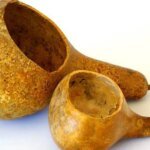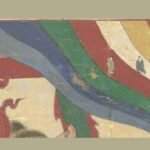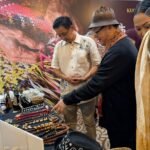

Aisha Odetunde’s thesis. c/o Wesleyan CFA
From Tuesday, March 25 to Saturday, March 29, 2025, the Ezra and Cecile Zilkha Gallery kicked off this year’s Art Studio Senior Thesis season with its first week of exhibitions. Showcasing the artwork of students Matty Shields ’25, Thomas Purello ’25, Tiffanie Cheung ’25, Sydney Smith ’25, Jane Lillard ’25, Maisy Lewis ’25, Lucy Brubaker ’25, and Aisha Odetunde ’25, the gallery drew in art enthusiasts from across campus and the broader community to witness these thought-provoking and innovative works of art.
As I entered the gallery, I was instantly captivated by the various mediums displayed collectively in the space. Ranging from sculptures to printmaking, this week’s exhibitions included various forms of mixed media that commanded viewers’ attention. My attention was immediately drawn to the natural beauty of Smith’s wooden sculptures for her thesis, “Reciprocity.” Inspired by reflective walks through the wilderness, her sculptures captured the sublime intersection between the natural world and the sculptor.
“As I started to carve into wood, I was constantly reminded of the living cycle of the piece, and my role to respect that relationship,” Smith wrote in a message to The Argus. “Cutting down my own trees for this process also sat with me as I worked, reminding me to pause and move slowly, to remember each piece as interrelated to the initial tree and ecosystem from which it was removed.”
Smith explained that the wooden sculptures are not merely shaped by her, but actively influence and shape the artistic process itself.
“Wood is also a material that always retains its own hand in the piece…. Whether it cracks as it dries and leaves unpredictable marks in ‘finished’ pieces, or chooses to bend a certain way after cautious cuts have been made, it continues to exist as an active agent in its own display, negating perfectionism and requiring a more dynamic work style,” Smith wrote.
Moving forward, Odetunde’s thesis, “Displacement,” offered a unique fusion of graphic design and printmaking. Using a blend of digital and traditional methods, Odetunde’s exhibit explored how mixed media and typography can create narratives and provide rich conceptual layers.

Jane Lillard’s thesis. c/o Maggie Smith
“I was inspired by words that hold weight, that lead to vulnerability and emotional aspects of the self,” Odetunde wrote in a message to The Argus. “Typography helped me illustrate how words can present themselves as a visual language. What was exciting about this process is how I used my writing and found text to make the words feel fragmented.”
In addition to discussing her artistic inspiration, Odetunde shared the profound impact she believes layered mediums have on a viewer.
“I enjoy how accessible it is to move between the digital and physical materiality while challenging the viewer to navigate through multiple content,” Odetunde wrote.
In a strikingly different yet equally emotional exhibit, Lewis presented her thesis, “Two Way Dream.” The project displayed both color and black-and-white 120mm medium photographs of the subject, Shawn Johnston. Capturing moments from several months of shooting, Lewis crafted a powerful visual narrative that immerses viewers in an emotional realm transcending physical boundaries. In a message to The Argus, Lewis described her artistic journey in creating her thesis.
“My thesis work was inspired by my own immersion into the world of someone else,” Lewis wrote. “Initially, my images were an exploration of physical space. But as I began to understand my subject and become immersed in his world, the resulting photos began to portray a unique psychological space; one of delusion and fantasy.”
She then shared her vision of the emotional effect she aimed to evoke through her artwork.
“I seek to portray a world that walks the line between fantasy and reality, and dream and nightmare,” Lewis wrote. “I seek to portray my subject as both victim and perpetrator, and as storyteller and archetype.”
Brubaker’s thesis, “Moon Beach,” used oil and acrylic paint to push the boundaries of abstraction and imagery in her creative process. Instead of focusing merely on the physical world, Brubaker sought to highlight the deeper emotional aspects of her subjects.
In a message to The Argus, Brubaker discussed her intentions to create a universally applicable piece.

Matty Shields’ thesis. c/o Maggie Smith
“Throughout the year, I was trying to strike a balance between attempting to evoke a certain feeling or foster an atmosphere, while not making the imagery of my paintings literal or concretely tied to my personal inspiration for them,” she wrote.
Brubaker also mentioned the importance of viewers’ individual and unique connections to her artwork.
“Of course, there are reactions that I’d hope to incite in the viewer, but I’m very cautious about not feeding a reaction to a viewer before they can have a subjective response,” she wrote.
Lillard’s thesis, entitled “conductors,” was an experimental approach to art that used monotype printmaking and plexiglass to capture the energy and movement of her subject matter: mosh pits. Inspired by her love for music, “conductors” was Lillard’s artistic expression of the dynamic atmosphere surrounding mosh pits. Each piece in her exhibition was created by an innovative process, producing one-of-a-kind artworks.
“I wanted to use this theme of mosh pits and music to relay energy, movement, and this visceral feeling that was really mirrored in the process,” she wrote in a message to The Argus.
Additionally, Lillard touched upon the satisfaction of showcasing her thesis in the gallery after investing so much effort into it.
“I had a really good time making these,” Lillard wrote. “Through all the stress, I really had a lot of fun and it was really gratifying seeing everything up in the gallery alongside my very talented peers.”
It would have been impossible to visit the Zilkha gallery without noticing the interactive exhibit of Purello’s thesis, “2674.” Using wood, he crafted toy swords that actively allowed visitors to engage with the artwork. In a message to The Argus, Purello commented that his thesis questioned traditional concepts of art and addressed how the physical engagements altered his pieces.

Thomas Purello’s thesis. c/o Maggie Smith
“I felt like my idea really challenged the way you’re meant to interact with the art gallery setting which was such a fun path to explore,” Purello wrote in a message to The Argus. “It was very difficult to come to terms with the fact that my pieces were going to get destroyed, but I’m essentially making toys for adults and what’s the point of a bunch of wooden swords if you aren’t going to swing them into each other.”
As I wrapped up my visit to the Zilkha gallery, I was stunned when I turned the corner and saw the exhibit “Want a Bag With That?” by Cheung. In her project, she embodied ideas of ephemera and mass production in sculptures constructed from a variety of recycled textiles, including rice and produce bags. In using repurposed materials, Cheung created cultural commentary on modern waste and consumption practices through her visually striking work of art.
“[The textiles’] mass production and seemingly singular use to transport fruit and other consumables were a sort of ephemera,” Cheung wrote in a message to The Argus. “I wanted to utilize these textiles’ malleability and emphasize their old identities, taking care to leave the ‘paid’ stickers on the rice bags intact and evidence of the produce bags’ past life as mandarin orange carriers.”
In the same vein, she addressed her use of sustainable practices in creating her thesis and the help she received from family members to make her sculptures possible.
“I inherited these materials second-hand from my generous extended family members,” Cheung wrote. “By choosing to work with used materials I sourced from my community, I tried to keep my thesis within this pre-existing circular material cycle.”
To close out the first week of this year’s exhibits, it’s essential to highlight Shields’ thesis, “Veil Ungrasped.” Employing materials sourced from former plantations in Georgia, Shields created a three-dimensional installation that immersed visitors in a multi-sensory fashion and prompted reflection on slavery in the South. Rather than using traditional exhibit practices, Shields involved the entire space of the room to evoke a profound emotional response.
“I was originally inspired by southern trees as living beings that have witnessed the immense trauma, violence, and complex history of slavery in the US South,” Shields wrote a message to The Argus. “They are immensely complex living organisms, not simply plants, that were used against their will as the tools of lynching and violence, absorbing and recording what they witnessed in each new growth ring that can be traced back to specific years.”

Tiffanie Cheung’s thesis. c/o Maggie Smith
He went on to emphasize the key messages he wished viewers would retain from his thesis.
“In my installation, I attempted to create a defined space for critical reflection and conversation between the viewer and the materials imbued with these powerful history, so different from any known history written in textbooks as fact or narrative, but instead a remnant of the lived trauma and experience of so many enslaved individuals,” Shields wrote. “I hoped that viewers would be confronted by the immense emotional and physical weight of these materials elevating above them and be forced to reflect on the history they hold within in a similar way that I sat with, reflected, and listened to these materials for six months in my studio before I ever constructed a single thing.”
All in all, the Art Studio Senior Thesis season has had an impressive start with a diverse array of mediums and materials. These artists have united to showcase their innovative approaches to artistic expression, exploring the ways their exhibits engage with space and visitors. We at The Argus are thrilled to see what’s in store for the following weeks.
Maggie Smith can be reached at mssmith@wesleyan.edu










